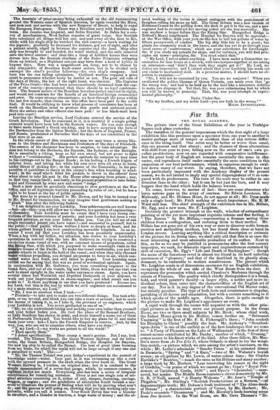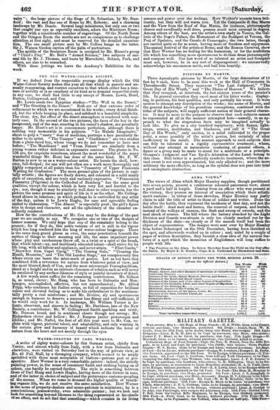Ant 3rtn.
THE ROYAL ACADEMY,
The private view of the Great Exhibition of the year in Trafalgar Square took place yesterday. .
The variation in the general impressions which the first sight of a large exhibition like this produces upon a spectator from one year to another is matter perhaps more of temper or accident than of any serious differ-
ence in the thing itself. One artist may be better or worse than usual, this one present and that absent ; and the chances of these alternations
will shift from year to year, falling now on the artist of one's own pe- culiar predilection, now on one regarded with comparative indifference : but the great body of English art remains essentially the same in cha- racter, and reproduces itself under essentially the same conditions in this emporium of our best performances, which is capacious enough to swal- low down many of our worst. In saying, therefore, that we have not been particularly impressed with the Academy display of the present season, we do not intend to hilly any special disparagement of it as com- pared with its predecessors. The turn of the scale may be rather in one direction than in the other ; but it can be but just the turn, and it may happen that the hand which holds the balance wavers.
To come, however, to matter of fact : there are some absentees who leave serious gaps in the array of canvass. Sir Edwin Landseer, Mr.
Mulready, and Mr. Holman Hunt, do not appear at all; Mr. Dyoe sends only a single head ; Mr. Frith nothing of much importance; Mr. E.- M. Ward still less. The chief strength of the exhibition lies in Mr. Millais, Mr. Egg, and a new man' Mr. F. Leighton. Certainly the greatest triumph on the walls, whether of extraordinary painting or of the yet more important requisite intense and fine feeling, is
The Rescue" by Mr Millais,—representing a fireman saving three children from a conflagration, and restoring them to their mother. Mr. Millais has not gone out of his own way or ours to discover noble human emotion and enthralling incident, but has found them close at hand in London streets. Leaving anything like a critical description or estimate of the picture for its fitting time, we shall only add that this is at once the most interesting and most admirable production of its author. Next to this, as far as we may be justified in pronouncing after the first cursory inspection, we rank, for dramatic vigour and impressiveness sustained by skill of execution, Mr. Egg's "Life and Death of Buckingham" ; though • the scene of the luxurious revel is almost too literal in its hard unfeeling coarseness of "pleasure," and that of the deathbed in its ghastly aban- donment, to be endurable to modern sensitiveness. The-picture which Mr. Leighton sends is of dimensions enormous for an English exhibition, occupying the whole of one side of the West Room from the door. It represents the procession which carried Cimabue's Madonna through the streets of Florence. The quality which chiefly distinguishes it is a bread, bold, and vivid painter's faculty—a larger style a nobler and more in- dividual colour, than enter into the characterittiLs of the English art of
our day. Nor is it in any degree of the conventional Old Master order' but strictly peculiar. The type of both form and countenance is singular,
partaking of ill-favour and emaciation, but with a certain something in it which speaks of the middle ages. Altogether, there is quite enough in the picture to make Mr. Leighton's appearance an event. A rapid walk through the rooms will acquaint us with the other prin- cipal pictures as far as 'may serve our present purpose. In the Great Room, are two or three small subjects by Mr. Hook; whose chief work the Infant Moses given to his Mother, comes further on. "Britomart Unarming" is the first of Mr. F. R. Pickersgill's three; "John sendeth his Disciples to Christ" possibly the best. • Mr. Anthony's "Stratford-
upon-Avon " is one of the earliest as of the best landscapes that we come to. "A Party of Pleasure on the Lake of Wallenstadt" is the first of three sunset-scenes contributed by Mr. Denby; another of which, " Evening," comes nearer to his fittest works of the kind. After these fellow' Mr. Mac- Bee's scene from As You Like It, where Orlando-is about to try the wrest- ling-matck—a picture which vexes among the artist's successes' on the whole Mr. Leslie's admirable " Sa,neho Faure " at his untested dinner in Barataria; "Spring" and "A Race,"—two of Mr. Webster's boyish
scenes ; an oil-picture by Mr. Lewis, of water-colour fame ; Sir Charles
Eastlake's "Beatrice ,"—much the same as his Heloise and many another; a large work by Mr. Herbert, "Lear recovering his reason at the sight
of Cordelia,"—i n praise of which we cannot go far; Cope's "Royal Pen- sioners at Carisbrook Castle, 1650"; and Dyce's " Christabel,"—man- lured, but tender. The Middle Room contains a clever domesticity by Mr. G. 13. O'Neill, named "A Hearty Welcome " ; Mr. Lear's "Temple of Phigaleia"; Mr. Stirling's "Scottish Presbyterians at a Sermon,"—of
daguerreotypic truth Mr. Dobson's fresh treatment of" The Alms-deeds of Dorcas"; a characteristic portrait of Vernet, by Mr. Herbert ; Mr, Poole's eccentric "Decaineron' ; and Mr. Horsley's book-burning scene from Don Quixote. In the West Room, are Mr. Cave Thomas's "lit-
'airy " ; the large picture of the Siege of St. Sebastian, by Mr. Stan- field ; the vast and fine one of Rome by Mr. Roberts; and a charming landscape by Mr. Deane. Several large miniature; but only one or two that caught our eye as especially excellent, adorn the Miniature Room; together with a tonsiderab e number of engravings. Of the North Room and the Octagon Room the merits are not so conspicuous as to challenge attention at first sight, and must be reserved for the detailed examina- tion. The one small picture sent by Mr. Collins hangs in the latter. Sir J. Watson Gordon carries off the palm of portraiture.
The middle of the Sculpture Room is occupied by Mr. Munro's group of " Child's Play." Mr. Bell's "Armed Science," two subjects of ani- mal life by Mr. J. Thomas, and busts by Marochetti, Behnes, Park, and others, are also to be remarked. With these jottings we leave the Academy's Exhibition for the week.



































 Previous page
Previous page